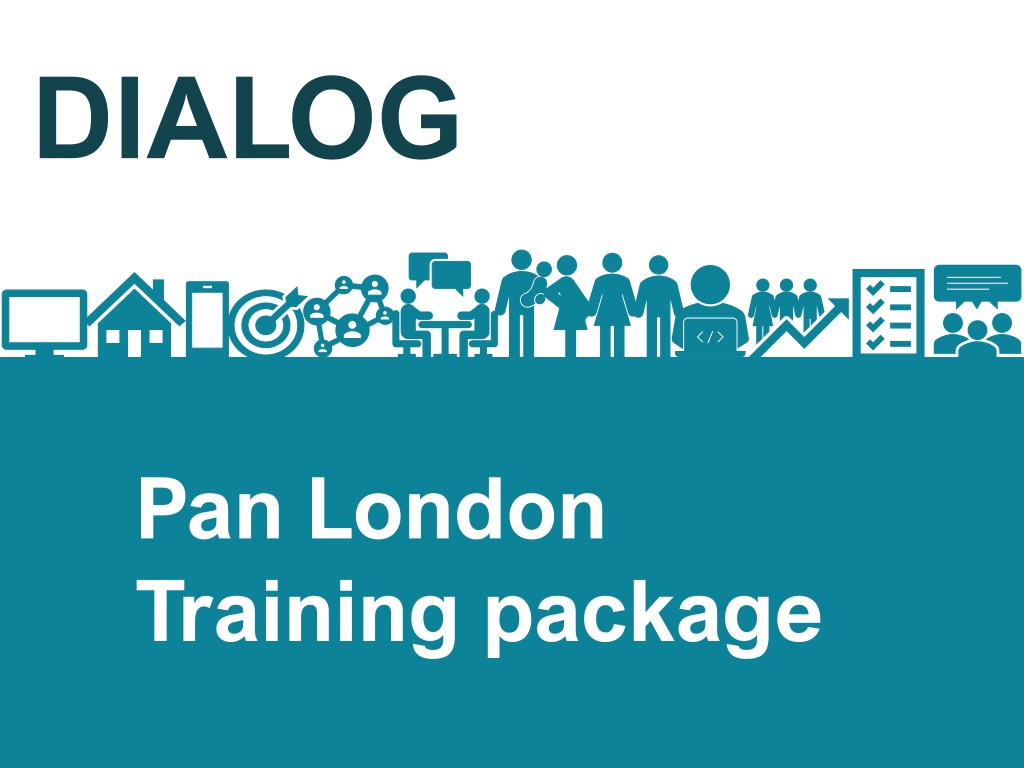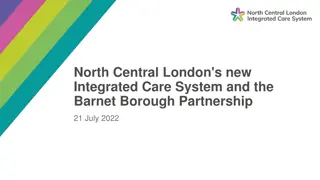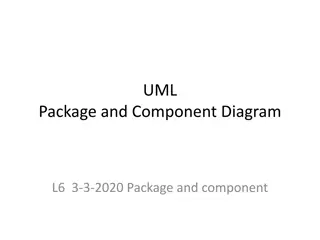DIALOG and DIALOG+ Training Package in London
Explore the DIALOG training package in London, covering topics such as what DIALOG involves, examples of data usage, patient feedback, rating criteria, use in electronic patient records, and more. Learn about the structured approach of DIALOG+ in addressing individual needs and wishes through a person-centered approach. Discover the 4-step process of DIALOG+ and how it can support care planning and problem-solving between patients and healthcare professionals.
Download Presentation

Please find below an Image/Link to download the presentation.
The content on the website is provided AS IS for your information and personal use only. It may not be sold, licensed, or shared on other websites without obtaining consent from the author.If you encounter any issues during the download, it is possible that the publisher has removed the file from their server.
You are allowed to download the files provided on this website for personal or commercial use, subject to the condition that they are used lawfully. All files are the property of their respective owners.
The content on the website is provided AS IS for your information and personal use only. It may not be sold, licensed, or shared on other websites without obtaining consent from the author.
E N D
Presentation Transcript
DIALOG Pan London Training package
Section 3 Section 1 Section 2 What is DIALOG? Useful examples of how data is starting to be used Patient feedback on DIALOG and DIALOG+ How to rate DIALOG DIALOG and DIALOG+ How to use DIALOG on EPR When should DIALOG be completed? How you can access DIALOG online Using DIALOG+ in the care plan Why DIALOG was agreed as the London PROM DIALOG as an outcome measure Recovery principles
What is DIALOG? DIALOG is a set of 11 simple questions that cover different area of a persons life. Relationships with friends and family Meeting with your mental health professional Practical help you receive Accommodation Medication Mental health Physical health Leisure activities Job Personal safety situation Friendships
DIALOG + DIALOG+ uses the scores identified by the person to take a structured approach to exploring their identified needs and wishes. It s a person- centred approach that can support care planning, find solutions and solve problems between the person and healthcare professional. DIALOG+ uses a 4 step approach Agreeing on actions agreeing on defined actions to improve the patient s condition and/or social situation. This step involves an agreement on specific and defined actions from the patient or the clinician or both. The agreed actions are briefly documented. Exploring options Looking forward Asking the patient about what practical actions might help to bring about the desired change. This covers actions taken by the patient, the clinician or someone else. directing the patient from a description of the problem to considering desired alternative scenarios. The patient is asked to imagine what changes he/she would like to see to replace the current undesirable situation. This can focus on long-term preferred outcomes and more short term small changes. Understanding Exploring both positive and negative aspects of the situation in the given domain. The person is first asked to explain the reasons for dissatisfaction and wishes for more help (or distress/concern in case of MH). Then the person is encouraged to consider existing strengths or coping strategies. To find out more information see the Operational Manual
Section 1 How to rate DIALOG How satisfied are you with . 1. Your mental health? 2. Your physical health? 3. Your job situation? 4. Your accommodation? 5. Your leisure activities? 6. Your relationships with your partner/family? 7. Your friendships? 8. Your personal safety? 9. Your medication? 10.he practical help you receive? 11.Your meeting with your mental health professionals? How satisfied are you with your meetings with mental health professionals? How satisfied are you with your mental Health? How satisfied are you with your physical health? How satisfied are you with your job situation? The first eight questions cover different areas of your life How satisfied are you with your accommodation? How satisfied are you with your leisure activities? How satisfied are you with your relationship with your partner/family? How satisfied are you with your friendship? How satisfied are you with your personal safety? How satisfied are you with your medication? and the last three are about your treatment How satisfied are you with your practical help you receive? DIALOG can help facilitate a person-centred approach by supporting meaningful conversations between service users and the healthcare professional about what aspects of their mental health are priorities for them.
How to rate DIALOG with one being totally dissatisfied and seven being totally satisfied. The survey is designed to measure how a person rates their quality of life and experience of the care that they receive. Fairly satisfied Totally satisfied Totally dissatisfied Fairly dissatisfied 2 Very 6 Very satisfied 1 7 3 4 5 In the middle dissatisfied
When should DIALOG be completed? London has agreed minimum time points in which DIALOG should be completed to ensure a standardised process Every 4 weeks for acutetreatment inpatients and crisis teams; no longer than 6 months ongoing treatment in community services and outpatient clinics). At the start of a new treatment episode i.e admission to an inpatient treatment, home treatment service, or other community service; referral to new provider organisation.) For acute treatment DIALOG should be carried out within 48 hours, for community setting obtained within first or second meeting Review For acute treatment DIALOG should be carried out within 48 hours, for community setting obtained within first or second meeting Episode start More frequent DIALOGs maybe carried out if embedded within CPA process or when carrying out DIALOG is clinically indicated At the end of treatment episode (discharge from a team, service or provider organisation). Episode end
Why has DIALOG been chosen as a London Patient Reported Outcome Measure (PROM)? London mental health partners came together to agree that DIALOG should be the London Patient Reported Outcome Measure (PROM). DIALOG was agreed to be used because .. The information can be used for planning for individual patients and whole services. The scale has been shown to have good psychometric properties. It is simple to use. It can be used to evaluate treatment and has the advantage that each item is meaningful. The use of DIALOG + has been shown to improve quality of life through a solution focused approach. Service users report satisfaction in using it.
DIALOG as an outcome measure PROMS provide services with a measure of the subjective impact of our services on a persons health and wellbeing. Healthcare professionals call this a patient reported outcome measure (PROM). It is an assessment of health status and health- related quality of life that comes directly from the patient. In London DIALOG has been agreed to be used for Early Intervention in Psychosis (EIP) and Care Programme Approach (CPA) services. DIALOG can be used in wider mental health service in the future.
CHIME framework Hope & Optimism Connectedness Having hope and optimism that recovery is possible and relationships that support this. Characterised by: motivation to change; positive thinking and valuing success; having dreams and aspirations Having good relationships and being connected to other people in positive ways. Characterised by: peer support and support groups; support from others; community. Identity Meaning Regaining a positive sense of self and identity and overcoming stigma Living a meaningful and purposeful life, as defined by the person (not others). Characterised by: meaning in mental illness experience ; spirituality; meaningful life and social goals.. Empowerment Having control over life, focusing on strengths, and taking personal responsibility. Source: Leamy et al 2011
Patient feedback on DIALOG and DIALOG+ Service users have described the benefits of using DIALOG and DIALOG+ Watch this short video to hear what service users who have used DIALOG think Monitor [Placeholder] Trusts to invite service users to provide their perspective on how DIALOG/+ has supported their recovery.
The data can be understood at an individual level. Here you can see that at the same time point satisfaction with physical health and accommodation has decreased which has also had an impact on the individuals mental health. Useful examples of how data is starting to be used There are different ways that the data can be understood and used to support a persons mental health and improve the quality of the service. The data can be used to better understand team needs. Here this shows why patients come in to the service beyond their mental health such as physical health, job situation and leisure activities. This can be used to direct focus around patients needs or for example staff skills and expertise. Source: this data is anonymised data taken from ELFT
Analysing DIALOG data DIALOG data can be analysed at an individual items level or represented as mean scores Reflection of scores: 1-3 = explicit dissatisfaction, 4 neutral middle, 5-7 explicit satisfaction High initial levels of satisfaction scores provide less scope for improvement (so called ceiling effect) whilst very low scores make improvements more likely (so called regression to the mean). For treatment satisfaction, absolute scores at a given time point more relevant than changes over time, ratings should consistently stay above 4 demonstrating a fair degree of satisfaction Organisation Individual Service Scores of single items of people in a service can be shown as means =average satisfaction scores or as a % of patients who have explicit dissatisfaction/satisfaction When considering changes over time global mean scores and single item analysis can be used depending on analysis Average subjective quality of life score of ALL patients in a service should not improve yet scores for the same patients should A change of overall means scores of >0.125 reflects an average improvement at least one scale point in at least one domain and may be a guide for overall meaningful improvement Treatment scores should consistently stay above 4 and % of patients with dissatisfaction kept to a minimum Used for an assessment of the personal problems and areas of strength Mean scores allows for review of data across every item For subjective quality of life scores below 4 require particular attention When evaluating treatment, any improvement in subjective quality of life is a meaningful increase Patients in long term care unrealistic to expect consistent and ongoing improvements personal context important Follows same principles as the interpretation for all patients in a service. Aggregating up means patient groups are very large, differences between mean scores tend to become smaller. % of explicit dissatisfaction or satisfaction rather than mean scores may be more informative
How to use DIALOG on EPR [Placeholder] Trusts to add in EPR information e.g screenshots and instructions of how to navigate your EPR system in relation to DIALOG
How to access DIALOG online [Placeholder] Trusts to add in EPR information e.g screenshots and instructions of how to navigate your EPR system in relation to DIALOG
Using DIALOG+ in the care plan [Placeholder] Trust might want to add examples of their care plans. DIALOG can improve the care plan process Where Trusts move towards DIALOG+ there may be an opportunity to streamline this process.






















